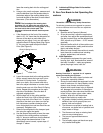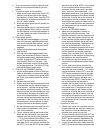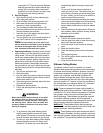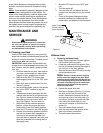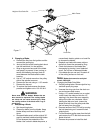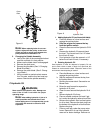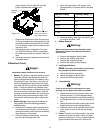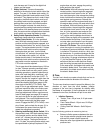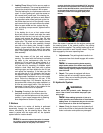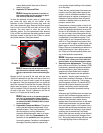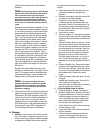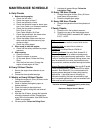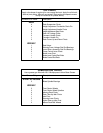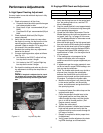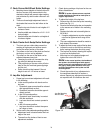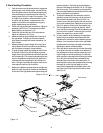
22
2.
Leaking Tires:
When a flat tire occurs, repair or
replace immediately. The normal procedure is to
remove the wheel and replace it with a spare.
Take the leaking tire to a maintenance area and
repair. If a tire is getting soft, park the mower on
the nearest level, paved area. If the leaking tire
is on a traction wheel, put blocks on each side of
the opposite traction wheel and jack up the tire
that leaks about an inch off the ground. Loosen
and remove the lug nuts and remove the wheel.
Mount a spare wheel and tire, replace the lug
nuts, and using a torque wrench, tighten them to
60
±
10 lb-ft.
If the leaking tire is on a front caster wheel,
block both traction wheels and raise the caster
wheel so that the tire is an inch off the ground.
Loosen and remove the locknut from the axle
assembly and pull the axle assembly from the
caster yoke. The wheel and two spacer sleeves
will drop free. Slip the axle assembly through
one side of the caster yoke, through a spacer
sleeve, a spare wheel, the other spacer sleeve
and finally through the other side of the caster
yoke. Then tighten the locknut on the end of the
axle assembly.
Lower the mower off the jack and continue
mowing. The wheel with the leaking tire should
be taken to the maintenance area, the tire
inflated to 20 psi and the wheel placed in a
large bucket of water. Carefully inspect the tire,
rim and valve for escaping air bubbles which
indicate a leak. Mark each leak with a yellow
marking crayon and then deflate the tire to 8 psi
and repeat the inspection. If the leaks you find
are pin hole size to 1/16" diameter, the tire can
be repaired using an aerosol can of tire inflater
and latex sealer available from any auto supply
store. Follow the directions on the can. If the
leaks are larger than 1/16" diameter, the tire can
be repaired with rubber plugs also available in a
kit from any auto supply store. If the tire bead is
damaged, a tube will have to be installed in the
tire or the tire will have to be replaced.
3.
Creeping:
Creeping is the slight forward or
backward movement of the mower when the
throttle is on and the lapbars are in the neutral
position. If your mower creeps refer to Steering
lever Adjustments Section G4, page 23.
F. Brakes
While the mower is in motion, all braking is performed
dynamically through the hydraulic pumps and traction
motors, controlled by the two steering levers. When the
mower is parked with the engine shut off, the hydraulic
system locks the traction wheels.
Note: To move the mower forward or in reverse
by pushing, you must release the dynamic braking.
Locate the valves on the pump. Turn valves
counter-clockwise (using a standard 7/16” wrench)
one quarter turn to push the unit. After pushing the
mower to the desired location, return both valves
to the operating position by turning the valve
clockwise, but do not overtighten (See photo
below)
Left Side Pump
Bypass
Valve
.
When the mower is parked with the engine running and
the steering levers in the neutral position, the parking
brakes should be applied. The parking brakes are drum-
type brakes mounted on each traction wheel. They are
both engaged by the same operating lever.
1.
Adjustments:
The parking brake handle is an
overcenter lever that should engage with moder
-
ate force.
Note: To increase parking brake capacity,
adjust brake cables at the brake arms equally.
Adjust the cable housing nuts one full turn and
check parking capacity. Repeat if parking brake
does not hold.
2.
Repair:
The mower is equipped with drum
brakes and will not normally require mainte
-
nance. If they are not working properly, please
contact your service center.
G. Hydraulic System
WARNING:
Never overfill the hydraulic units. Damage can
occur if the oil level is not within the proper oper
-
ating range.
Note: When adding hydraulic oil, do so in
small quantities and recheck the oil level before
adding more. It is important that you do not over
-
fill the reservoir to allow for fluid expansion.
1.
Hoses:
Check the hoses from the hydraulic oil
tank to the oil filter to the hydraulic lines daily for
leaks or abrasion and replace any damaged



